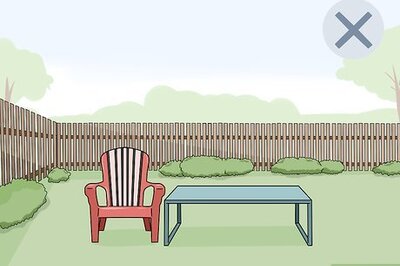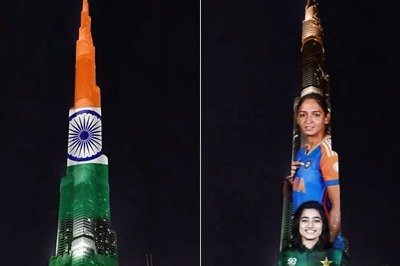
views
New Delhi: Over three decades in making but India's indigenous Light Combat Aircraft (LCA) Tejas is yet to be fully operational and battle ready. The LCA project was sanctioned in August 1983 with a cost of Rs 560 crore in order to replace the MiG-21 fighters in the Indian Air Force arsenal. But even after overshooting the budget by a huge margin and missing several deadlines, the LCA Tejas Mark-I fighter is deficient on 53 parameters reducing the fighter's operational employability and is yet to be inducted in IAF squadrons.
Even though the LCA was given Initial Operational Clearance (IOC) in December 2013 but it has failed to meet the IAF's standards due to a large number of issues plaguing the fighter. As per the initial plan which had a development schedule of eight to 10 years, the first set of LCA should have been ready by 1994.
But according a Comptroller and Auditor General report tabled in Parliament on Friday, the project is way couple of decades behind schedule, mainly on account of design changes necessitated due to change in weapon requirements, non-availability of Kaveri engine, delay in completion of work packages by the work centres, etc. There is still no indigenous engine for the fighter jet as Gas Turbine Research Establishment, Bangalore failed to develop the Kaveri engine as per the LCA schedule and specifications, necessitating Aeronautical Development Agency (ADA) to import GE-F404-IN20 aero engine from GE, USA to continue the development activities.
More than 30 years have passed since the LCA Programme was given the green signal but the fighter only achieved Initial Operational Clearance in December 2013 after a delay of eight years and the Full Operational Clearance, which was scheduled to be completed by December 2008, is now expected to be to be achieved only by December 2015.
CAG report says the slippages have occurred due to the bottlenecks in execution of LCA project, extent of meeting Air Staff Requirement including weaponisation, ADA's decision to advance building of two prototypes from Full Scale Engineering Development (FSED) Phase-II to FSED Phase-I on the ground of accelerating the development process of LCA, failed to yield the desired results as the FSED Phase I was closed in March 2004 involving a delay of six years and without completing all the activities, which were carried forward to FSED Phase-II.
This decision of ADA rendered the prototypes deficient of critical onboard systems (Multi-Mode Radar, Self-Protection Jammer, Radar Warning Receiver) and led to ADA using the Limited Series Production aircraft (meant for IAF use) towards flight testing/evaluation of these critical on board systems, in contravention to the commitment given to the Government of India while obtaining sanction in November 2001 for building of these aircraft.
LCA Mark-I, which achieved Initial Operational Clearance in December 2013, has significant shortfalls (53 permanent waivers/concessions) in meeting the ASR as a result of which, it will have reduced operational capabilities and reduced survivability, thereby limiting its operational employability when inducted into IAF squadrons. Shortcomings in LCA Mark-I (increased weight, reduced internal fuel capacity, non-compliance of fuel system protection, pilot protection from front, reduced speed) were expected to be overcome by development of LCA Mark-II, an aircraft with lower weight and a higher thrust engine which is expected to meet the ASR, had been taken up by ADA in November 2009 and is scheduled for completion by December 2018.
In one of the most glaring omissions, IAF would be inducting LCA fighters without the availability of trainer LCA which will adversely impact pilot training. Production of trainer aircraft at HAL was delayed as the trainer LCA had not achieved IOC/FOC. As regards flight training simulator, IAF was using an upgraded Full Mission Simulator (FMS) at ADE for pilot training, pending supply of a FMS by HAL at LCA operating base.
Following the addition of new weapons by Air HQ for operational edge of LCA in March 1997 and then again in December 2009 necessitated design changes on the aircraft, coupled with delayed specifying (December 2009) of integrating R-73E missile with Multi-Mode Radar/Helmet Mounted Display and Sight and delayed identification (December 2009) of Beyond Visual Range Missiles also contributed to the delays in achieving IOC/FOC by LCA.
LCA Mark-I is also deficient in Electronic Warfare capabilities which are mandatory in any modern fighter. LCA has no Self Protection Jammer due to space constraints and the Radar Warning Receiver/Counter Measure Dispensing System fitted on the aircraft are having performance issues.
Even the level of indigenisation planned has not been achieved by the LCA programme. In June 1993 the government had emphasised on increasing the indigenous content of LCA while sanctioning FSED in phased manner, but even in January 2015 the indigenous content of LCA which was estimated by ADA as 70 per cent actually worked out to about 35 per cent.
Several critical components including the Kaveri engine, Multi-Mode Radar, Radome, Multi-Functional Display System and Flight Control System Actuators taken up for indigenous development could not be developed successfully, resulting in their import. Even development of Jet Fuel Starter, though achieved indigenously, had performance issues which are yet to be resolved.
The prototype version (PV) and Limited Series Production (LSP) of LCA3 built by Hindustan Aeronautics Limited (HAL) had low serviceability due to delay in snags analysis, slow recovery of aircraft from rectification, shortage of critical LRUs at flight hangar, aircraft being used as test rigs, large number of unproductive sorties etc. which impacted availability of aircraft for flight testing and contributed to delays in development of LCA.
The manufacturing facilities created at HAL presently cater for production of only four aircraft per annum against the envisaged requirement of eight aircraft per annum due to delays in procuring plant and machinery, tools and jigs and also construction of production hangars, which would further impact production of LCA and induction into IAF squadrons.
Such a huge delay in the programme has force the IAF to upgrade its existing fleet at a considerable cost to ensure that its already depleting squadrons are not left with obsolete jets. The upgradation of existing aircraft has cost the IAF Rs 20,037 crore and involved the MiG-21 BIS, Mirage 2000, Mig-29 and Jaguar fleet.
After the LCA programme was sanctioned, the IAF in October 1985 issued Air Staff Requirement (ASR) with a projected requirement of 200 LCA fighters and 20 trainers to be inducted by 1994 but neither of the two has been fully operationalised compromising the country's air defence.
The LCA was envisaged as a light weight multi-mission fighter aircraft, having contemporary air combat and offensive air support capabilities with excellent maneuverability for close air combat at low and medium altitudes in order to ensure extended air defence cover over the forward bases and tactical battle areas.
But the delay has ensured that IAF pilots continue to fly the MiG-21 which were first inducted in 1966 with the last of the fighters joining the fleet in 1987. A majority of MiG-21 aircraft were expected to be phased out in the 1990s with the LCA replacing them.
LCA Tejas not yet a potent fighter, deficient on 53 parameters, delays hurting IAF: CAG

















Comments
0 comment